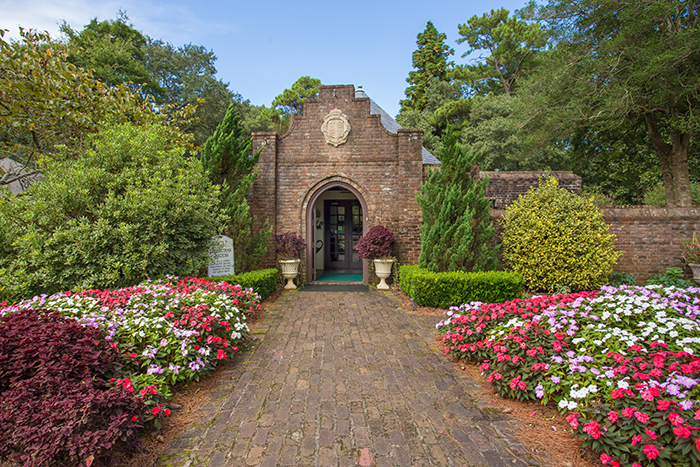Elizabethan Gardens
Beauty, history, and a restful experience.

It is amazing how much beauty and variety the Elizabethan Gardens on the north end of Roanoke has managed to fit into 10 acres. And what is perhaps most wonderful is the feeling of the Gardens is peaceful, serene, and restful.
Strolling along the shaded paths, flowers are constantly in bloom. In the summer, crepe myrtles, black-eyed Susans, hydrangeas, and hibiscus are just some of the flowers that fill the air with color and the perfume of flowers.
Even in the winter, Camellias and azaleas flower in the garden. To have flowers constantly in bloom, a garden filled with scent, color, and life was the guiding idea from the time a formal garden next to the Waterside Theater where The Lost Colony is performed was proposed.
According to the history of Elizabethan Gardens, in 1950 after seeing a performance of The Lost Colony, several members of the Garden Club of North Carolina began to wonder what would have happened if the Lost Colony had managed to survive. In their imagination, the colonists would have, at some point, created a formal garden much like the formal gardens of England.
It took 10 years, but on August 18, 1960, the Elizabethan Gardens officially opened.
From that time, it has remained true to the original concept of an English formal garden, but it is probably like no other formal garden anywhere. There is so much to see and admire on the grounds that it’s difficult to point to any one thing.
The flowers, flowering trees, and plants are certainly at the heart of what the Elizabethan Gardens is. There is a small rose garden that has some rare roses, and a rose bush donated by Her Royal Highness Queen Elizabeth from her garden.
There is a butterfly garden that almost seems in motion at times.
Yet, although the flowers are the centerpiece of the garden, perhaps the most remarkable feature of the Gardens is the statuary.
The Sunken Garden is designed to be the focal point of the Gardens. The centerpiece of the Sunken Garden is a beautiful ancient Italian fountain and pool with a carved balustrade. Surrounding the fountain is Italian statuary bearing the coat-of-arms of the Farnesi family of 16th century Italy. The Farnesi family was one of the largest patrons of Michelangelo, although it is very doubtful that the master created the statuary.
It is, though, a statue of a young lady that may have the most remarkable story. Carved by 19th-century American sculptor Maria Louise Lander, the statue of Virginia Dare was created in Lander’s Rome studio toward the end of the 1850s.
Placed on a ship to be sent to Boston, the ship foundered off the coast of Spain, and the statue spent two years beneath the sea. When it was salvaged, Lander repurchased the statue and went to work restoring her art.
On display in Boston for a few years, it was purchased for $5000, but the purchaser died before the sale was finalized and the executors of the estate refused to recognize the sale.
Virginia Dare almost went to the Chicago 1893 World’s Fair, but North Carolina did not have the money to purchase it, and so it stayed in Lander’s possession. When she died in 1923, her will gave the statue to the Historical Society of North Carolina.
The display life of the statue was short-lived. The half-nude figure of a woman was deemed obscene, and the statue was placed in storage until it was donated to the Elizabethan Gardens.
Although the Gardens are thought of as a mostly summer or perhaps spring or even fall activity, one of the year’s most popular events is Winter Lights.
Beginning the week before Thanksgiving and running through the end of the year, Winter Lights turns the dark of a December night into magic as tens of thousands of miniature lights illuminate the trees and statuary of the Gardens. Part of the magic takes place at the Great Lawn, which is in the heart of the Gardens. There is always a roaring pit fire with free marshmallows and tongs for roasting waiting for children of all ages to toast a marshmallow or five.
The Elizabethan Gardens is open year-round except for February. (Closed Thanksgiving and the day before, closed Christmas and Christmas Eve.) While our gardens grace us with blooms year-round, we have many seasonal events and programs blooming with activity too. Visit their website to learn more! https://www.elizabethangardens.org/
